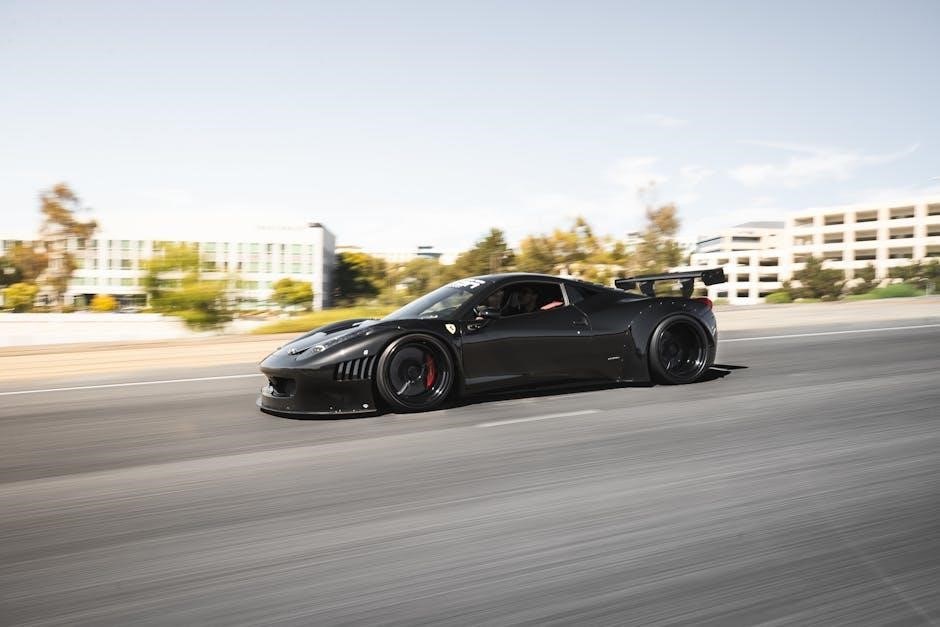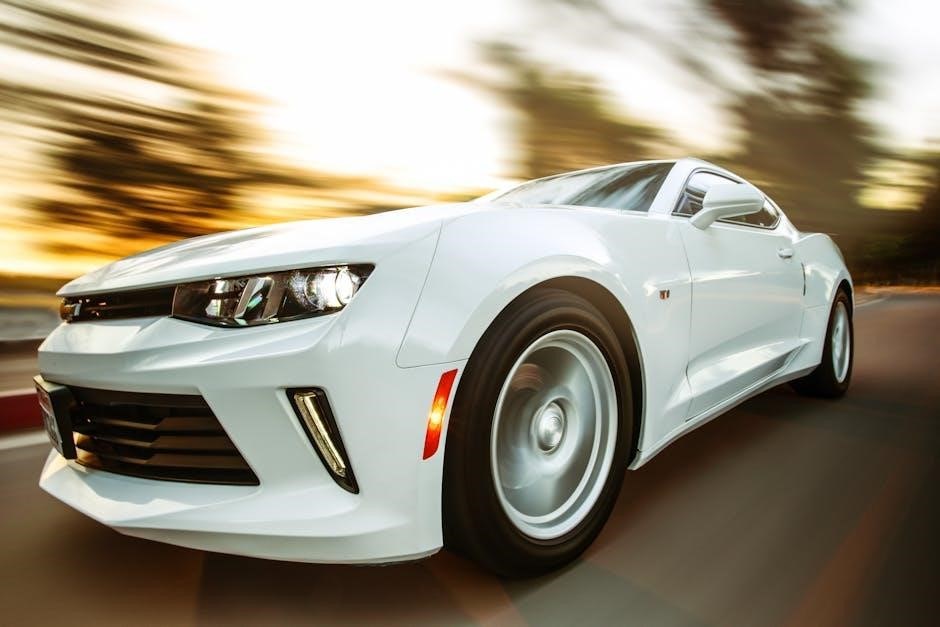
are race cars automatic or manual
Most race cars utilize manual transmissions, particularly sequential gearboxes, for precise control and faster shifting. However, some racing categories, like drag racing, favor automatic transmissions for quick acceleration.

Manual vs. Automatic Transmissions in Race Cars
Race cars predominantly use manual transmissions, especially sequential gearboxes, for precise control and rapid shifting. Automatics are favored in drag racing for swift acceleration.
Overview of Manual Transmissions in Racing
Manual transmissions dominate racing due to their precision and control. Race cars often use sequential gearboxes, which allow rapid, sequential shifts without needing to press a clutch. These transmissions are lightweight and designed for high-performance, enabling drivers to maintain control during intense maneuvers. Unlike automatics, manuals provide direct driver engagement, making them preferred in most professional series. The lack of torque converter and mechanical efficiency contribute to faster lap times. Sequential manual transmissions, like those in Formula 1, use paddles for shifting, eliminating the need for a clutch pedal. This setup optimizes speed and consistency, making manual transmissions the standard in competitive racing.
Overview of Automatic Transmissions in Racing
Automatic transmissions are less common in racing but excel in specific categories like drag racing, where quick acceleration and simplicity are crucial. They eliminate the need for manual shifting, reducing driver workload and allowing focus on other aspects like braking and steering. Automatics with manual valve bodies, such as the TH400, are popular in drag racing for their durability and ability to handle high torque. These transmissions are often preferred in series where rapid, unvaried acceleration is prioritized. However, their weight and complexity can be drawbacks compared to manual gearboxes. Despite this, automatics remain a viable choice for certain racing applications, offering unique advantages in specific scenarios.

Types of Manual Transmissions in Race Cars
Racing manual transmissions include sequential gearboxes, dual-clutch transmissions, and traditional H-pattern designs, each offering distinct advantages in terms of speed, control, and driver interaction.
Sequential Gearboxes
Sequential gearboxes are widely used in race cars for their quick and seamless shifting capabilities. Unlike traditional manual transmissions, sequential gearboxes allow drivers to shift gears in a fixed order, typically using a lever or paddle-shift system. This design eliminates the need for a clutch pedal in most cases, streamlining the shifting process. Sequential gearboxes are particularly popular in Formula 1, endurance racing, and rally racing, where rapid gear changes are critical. They are often lighter and more durable than traditional manuals, making them ideal for high-performance applications. The non-synchronous design ensures precise control, and their compact construction suits the aerodynamic demands of modern race cars.
Dual-Clutch Transmissions (DCT)
Dual-Clutch Transmissions (DCT) combine elements of manual and automatic systems, offering rapid gear shifts without manual intervention. DCTs use two clutches to pre-select gears, enabling faster shifts than traditional manuals. Common in sports cars and lower-tier racing series, DCTs provide smooth acceleration and adaptability to various driving conditions. Unlike purely automatic transmissions, DCTs maintain a connection to the engine, enhancing driver engagement. They are lighter and more fuel-efficient than automatics with torque converters. DCTs are favored for their balance of performance and convenience, though they are generally more expensive than traditional manual transmissions. Their popularity extends beyond racing into high-performance road vehicles, where precise control and quick shifting are essential.
Traditional H-Pattern Manual Transmissions
Traditional H-Pattern manual transmissions are iconic for their driver engagement and simplicity. With a clutch pedal and gear lever arranged in an “H” pattern, these transmissions require precise driver input. While less common in modern racing due to the rise of sequential and dual-clutch systems, they remain popular in certain series where regulations mandate their use. H-Pattern transmissions offer a direct mechanical connection, allowing drivers to feel each gear change. They are lighter and less complex than automatics, making them a cost-effective choice for some teams. However, their slower shifting compared to sequential gearboxes can be a disadvantage in high-level competition, where every fraction of a second counts.

Types of Automatic Transmissions in Race Cars
Automatic transmissions in race cars include semi-automatic and manual valve body systems, often used in drag racing for quick acceleration and torque delivery.
Semi-Automatic Transmissions
Semi-automatic transmissions in race cars combine elements of manual and automatic systems. They do not use a clutch pedal but rely on electronic or hydraulic systems to change gears. These transmissions are commonly found in high-performance racing series like Formula 1, where drivers use paddle-shifters or buttons to select gears. Semi-automatic transmissions offer faster shift times compared to traditional manual gearboxes, reducing driver error and improving lap times. They are particularly advantageous in endurance racing, where consistent performance and reduced driver fatigue are critical. Despite their complexity, semi-automatic transmissions have become the standard in many professional racing categories due to their blend of driver control and automated efficiency.
Automatic Transmissions with Manual Valve Bodies
Automatic transmissions with manual valve bodies are a hybrid solution commonly used in drag racing. These transmissions combine the strength of automatics, such as rapid acceleration, with manual control over gear shifts. The TH340, TH400, and Glide are popular choices, offering durability and high torque capacity. By retaining a manual valve body, drivers can engage gears manually, which is crucial for optimizing performance in short, high-intensity races. This setup allows for precise control over shift timing, making it ideal for drag racing where milliseconds can determine the winner. The ability to customize shift points and firmness enhances traction and reduces slippage, giving drivers a competitive edge on the track.

Manual Transmissions in Specific Racing Series
Formula 1 exclusively uses sequential manual transmissions for precise control and rapid shifting. Other professional series, like endurance racing, also favor manuals for their performance and driver engagement.
Formula 1 (F1) and Sequential Manual Transmissions
Formula 1 cars exclusively use sequential manual transmissions, which are semi-automatic in nature. These gearboxes require driver input through paddle-shifters, allowing for rapid gear changes without a clutch pedal. F1 transmissions typically feature 8 forward gears and 1 reverse gear, with fixed ratios optimized for performance. The system uses a single clutch, unlike dual-clutch transmissions, and is designed for minimal weight and maximum reliability. This setup enables drivers to focus on steering and braking while maintaining precise control over shifting. The sequential nature of the gearbox ensures seamless transitions between gears, a critical factor in F1’s high-speed, competitive environment. This technology has become a cornerstone of F1’s performance and racing strategy.
Other Professional Racing Series and Manual Transmissions
Beyond Formula 1, many professional racing series rely on manual transmissions for their performance and control benefits. Championships like the World Endurance Championship (WEC) and IMSA often use sequential manual gearboxes, similar to F1, for their reliability and quick shifting. In endurance racing, manual transmissions are preferred due to their durability and driver engagement. Series such as IndyCar also utilize semi-automatic transmissions with paddle-shift systems, optimizing performance in high-speed conditions. These transmissions are tailored to the specific demands of each series, ensuring precise gear control and enhancing overall race performance. Manual transmissions remain a staple in these professional circuits, where driver input and mechanical efficiency are crucial.

Automatic Transmissions in Specific Racing Series
Drag racing heavily favors automatic transmissions for rapid acceleration, often using TH340, TH400, or Glide models with manual valve bodies. Other series also adopt automatics for specific performance benefits.
Drag Racing and Automatic Transmissions
Drag racing predominantly uses automatic transmissions due to their ability to deliver rapid, consistent acceleration. Cars in this category often feature transmissions like the TH340, TH400, or Glide, equipped with manual valve bodies for precise control. Automatics are favored because they minimize driver error during shifts, crucial in short, high-speed races. The instantaneous torque delivery and smooth power transfer of automatic transmissions make them ideal for drag racing’s emphasis on quick starts and maximum acceleration; While other racing series may lean toward manual or sequential gearboxes, drag racing’s unique demands make automatic transmissions the preferred choice for optimal performance and reliability.
Other Forms of Racing with Automatic Transmissions
Beyond drag racing, automatic transmissions are utilized in various motorsport disciplines where quick, seamless acceleration is critical. Stock car racing often employs automatics for simplicity and durability, reducing driver workload during long events. Rally racing sometimes incorporates automatic transmissions in certain classes, particularly for novice drivers, to ease vehicle control on diverse terrains. Additionally, some endurance racing series allow automatic transmissions to minimize fatigue and optimize pit strategy. While not as prevalent as manual or sequential transmissions in most professional categories, automatics find niches where their benefits in ease of use and consistent performance outweigh the need for manual control, making them a practical choice in specific racing contexts and series regulations.

Comparison of Manual and Automatic Transmissions
Manual transmissions dominate race cars, offering quick shifting and driver control. Automatics excel in drag racing, providing effortless, faster gear changes, optimizing acceleration over short distances.
Driver Control and Performance
Manual transmissions provide race car drivers with precise control over gear selection, allowing them to optimize acceleration and cornering. Automatic transmissions, while offering faster shifts, reduce driver input. In racing, manuals enable drivers to fine-tune their driving style, crucial for competitive performance. Automatics, however, rely on pre-programmed algorithms, limiting direct control. Despite this, dual-clutch automatics mimic manual-like performance, blending speed and efficiency. Ultimately, manual transmissions remain the preferred choice in most racing series, as they allow drivers to fully engage with the vehicle’s dynamics, enhancing overall racing strategy and responsiveness.
Weight and Complexity
Manual transmissions are generally lighter and less complex than automatics, making them preferred in racing for better power-to-weight ratios. Sequential gearboxes, commonly used in race cars, are designed for simplicity and durability. Automatic transmissions, while offering advanced technology, add weight due to components like torque converters and complex electronic systems. Dual-clutch transmissions (DCTs) strike a balance, combining manual-like performance with automated shifting, but still weigh more than traditional manuals. The added complexity of automatics can also lead to higher maintenance needs. In racing, where every kilogram and millisecond matters, manual transmissions often provide a competitive edge in terms of weight and mechanical simplicity.
Cost and Maintenance
Manual transmissions are typically more cost-effective and require less maintenance compared to automatics. Their simpler design means fewer components to replace or repair. Automatic transmissions, especially dual-clutch systems, are more complex and expensive to maintain due to advanced electronics and multiple clutches. However, modern automatics often justify their higher cost with improved performance and durability in racing conditions. Manual transmissions remain a budget-friendly option for many race teams, while automatics are chosen for their technological advantages. Maintenance costs for manuals are generally lower, but high-performance automatics may require specialized care, balancing initial investment with long-term benefits in competitive racing environments.

Manual Transmissions in Modern Racing
Modern race cars often use sequential manual transmissions for precise control and rapid shifting, enhancing performance in competitive environments.
Paddle-Shift and Semi-Automatic Systems
In modern racing, paddle-shift and semi-automatic systems have become prevalent, blending manual control with automated efficiency. These systems allow drivers to shift gears without removing their hands from the steering wheel, enhancing control and reducing fatigue. Paddle-shift systems, commonly used in Formula 1, enable rapid gear changes, optimizing performance in high-speed environments. Semi-automatic transmissions combine manual driver input with automated clutch operation, offering a balance between precision and ease of use. This technology has revolutionized racing, providing faster and more seamless shifting while maintaining the driver’s ability to fine-tune their performance. Such systems are integral to modern race cars, representing the evolution of manual transmissions in competitive motorsport.
Advancements in Manual Transmission Technology
Modern manual transmissions in race cars have seen significant advancements, focusing on lightweight materials and improved durability. Carbon fiber and titanium components are now common, reducing weight while maintaining strength. Gear engagement systems have been refined, offering faster and smoother shifts. Additionally, electronic aids like automated clutch systems and gear sensors optimize performance, reducing driver error. These innovations ensure manual transmissions remain competitive, even as automatic and semi-automatic options gain traction. The integration of advanced materials and smart technologies has elevated manual transmissions to meet the demands of high-performance racing, ensuring they continue to play a vital role in motorsport.

Automatic Transmissions in Modern Racing
Modern racing sees automatic transmissions gaining traction, especially in drag racing, where quick launches are crucial. Dual-clutch technology enhances performance, offering faster shifts than traditional manuals.
Dual-Clutch Technology and Automatic Transmissions
Dual-clutch transmissions (DCTs) combine the efficiency of manuals with the convenience of automatics. They use two clutches to pre-select gears, enabling lightning-fast shifts without torque interruption. In racing, DCTs are praised for their seamless performance, especially in high-speed scenarios where instant gear changes are critical. Unlike traditional automatics, DCTs eliminate the need for a torque converter, reducing weight and complexity. This technology is widely adopted in modern race cars, offering a balance between driver control and mechanical efficiency. DCTs are particularly popular in series like GT racing, where their precision and speed provide a competitive edge. They represent a significant advancement in automatic transmission technology for motorsports.
Future Trends in Automatic Racing Transmissions
Future trends in automatic racing transmissions point toward increased integration of advanced technologies like AI-driven gear shifting and hybrid systems. These innovations aim to enhance efficiency without sacrificing performance. Automatic transmissions may adopt modular designs, allowing easier customization for specific racing series. Electrification could also play a role, with hybrid automatics optimizing power delivery in endurance races. Additionally, the development of smarter transmission control units (TCUs) will enable real-time adaptations to driving conditions, further blurring the line between manual and automatic systems. These advancements promise to make automatic transmissions even more dominant in various forms of motorsport, catering to both performance and regulatory demands.

Additional Resources
For further exploration of race car transmissions, visit reputable automotive websites like Car and Driver or Motor Trend for detailed articles. Books on racing technology, such as “The Racing Manual” by John Blunsden, offer in-depth insights. Online forums like Reddit’s racing communities provide discussions and firsthand experiences. Technical documents from racing series like Formula 1 or NASCAR detail transmission specifications. Manufacturer websites, such as Bosch or Xtrac, share technical insights and case studies. Video tutorials on platforms like YouTube explain transmission mechanics visually. Engineering journals and academic papers also provide scholarly perspectives on transmission technology. These resources collectively offer a comprehensive understanding of race car transmissions for enthusiasts and professionals alike.
Related posts:
Archives
Calendar
| M | T | W | T | F | S | S |
|---|---|---|---|---|---|---|
| 1 | 2 | 3 | 4 | |||
| 5 | 6 | 7 | 8 | 9 | 10 | 11 |
| 12 | 13 | 14 | 15 | 16 | 17 | 18 |
| 19 | 20 | 21 | 22 | 23 | 24 | 25 |
| 26 | 27 | 28 | 29 | 30 | 31 | |
Leave a Reply
You must be logged in to post a comment.